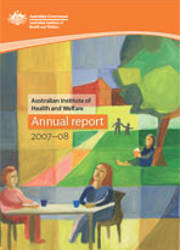Summary
Who we are
The main functions of the Australian Institute of Health and Welfare (AIHW) relate to the collection, analysis and dissemination of health-related and welfare-related information and statistics. These functions are specified in s. 5 of the Australian Institute of Health and Welfare Act 1987 (AIHW Act). In summary, the AIHW:
- identifies and meets the information needs of governments and the community to enable them to make informed decisions to improve the health and welfare of Australians
- provides authoritative, timely information and analysis to the Australian Government, state and territory governments and all Australians by collecting, analysing and disseminating national data on health, community services and housing assistance
- develops, maintains and promotes, in conjunction with stakeholders, information standards for health, community services and housing assistance.
The AIHW promotes and releases most of its results into the public domain.
How we are governed
The AIHW was established as a statutory authority in 1987 by the Australian Institute of Health Act 1987 to report to the nation on the state of its health. In 1992, the role and functions of the then Australian Institute of Health were expanded to include welfare-related information and statistics, making it the Australian Institute of Health and Welfare. The Act is now entitled the Australian Institute of Health and Welfare Act 1987 (Appendix 2 Legislation, page 163).
Subject to strict confidentiality provisions in the AIHW Act and with the agreement of its Ethics Committee, the AIHW may release data to other bodies or persons for research purposes.
Our reporting framework
The AIHW's outcome as stated in the 2007-08 Portfolio Budget Statements for the Health and Ageing portfolio is 'Better health and wellbeing for Australians through better health and welfare statistics and information'.
The AIHW has one output group: 'Develop, collect, analyse and report high-quality national health and welfare information and statistics for governments and the community'. See Chapter 2 Performance, page 29 for more information.
The AIHW prepares a set of annual financial statements as required by the Finance Minister's Orders made under the Commonwealth Authorities and Companies Act 1997 and the Australian Accounting Standards. These financial statements are audited by the Australian National Audit Office. The detailed financial statements and the auditor's report are contained in Appendix 1, page 123.
How we are funded
In 2007-08 the AIHW received 29% of its funding as an annual appropriation from the Australian Government.
Over the years, the annual appropriation has been increasingly supplemented by funding from Australian and state government departments and agencies for work on specific projects. Most funding is now for specific projects. The deliverables and funding for each of these projects are negotiated with the funder.
Summary of financial performance
The AIHW's financial results against the 2007-08 Budget Estimates contained in the 2007-08 Portfolio Budget Statements and the actual results for 2006-07 are summarised in Table 1.
In 2007-08, the AIHW's appropriation funding from the Australian Government was $8.678 million, an increase of 0.6% over the previous financial year.
External fee revenue increased by 24% over the previous financial year to a record high. Most of this income came from Australian Government departments. The growth in this revenue has been particularly strong for work on Aboriginal and Torres Strait Islander health and welfare.
Expenditure on employees and suppliers increased in line with the growth in revenue.
The AIHW had received approval from the Minister for Finance and Administration to budget for a deficit of $730,000 for the year due to cost pressures on core appropriation-funded work. The actual deficit was slightly higher than budgeted (by $34,000, or 0.1% of total expenditure) due to essential one-off expenditure incurred late in the year.
| Actual 2007-08 $'000 | Estimates 2007-08 $'000 | Actual 2006-07 $'000 | |
|---|---|---|---|
| Revenue | |||
| Appropriation revenue | 8,678 | 8,718 | 8,625 |
| Total revenue from other sources | 20,922 | 15,703 | 16,661 |
| Total revenue | 29,600 | 24,421 | 25,286 |
| Expenditure | |||
| Employees | 18,437 | 16,058 | 15,426 |
| Other expenditure | 11,927 | 9,093 | 10,184 |
| Total expenditure | 30,364 | 25,151 | 25,610 |
| Deficit | (764) | (730) | (324) |
Trend analysis
The AIHW's revenue from appropriation and external fees since the creation of the AIHW in 1987 is shown in Figure 1.
Over the last 10 years appropriation income has increased by a compound rate of just 1.1% a year. The proportion of income from appropriation has decreased from almost 100% in 1987-88 to 29% in 2007-08.
Figure 2 shows that staff numbers have increased in line with the growth in the AIHW's revenue. The increase in the number of staff in 2007-08 was the largest increase in a single year.
Figure 1: Revenue history, 1997-98 to 2007-08

Figure 2: Total staff numbers 1988-2008

Flagship publications
In alternate years the AIHW is required by its Act to publish Australia's health and Australia's welfare, both of which are key national resources for these major areas. In addition, the AIHW publishes a comprehensive report in conjunction with the Australian Bureau of Statistics on the health and welfare of Australia's Aboriginal and Torres Strait Islander peoples.
- Australia's health 2008
- Australia's welfare 2007
- The health and welfare of Australia's Aboriginal and Torres Strait Islander peoples 2008



